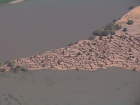|
Thanks to another early start, we took off
from Mopti shortly after 9 a.m., still early enough to fly low at 3500
feet to enjoy the view of the Niger and the villages along its banks on
our way to the legendary Timbuktu.
Abdullaye (our Dogon country guide) had put
us in touch with a Timbuktu guide, Kalilou, who met us at the airport
with a landcruiser and driver. Compared with Abdullaye, Kalilu was
disappointing. He wanted to charge us more to have the landcruiser at
our disposal all day, just around Timbuktu, than we paid for two long
and rough rides in the Dogon country. In any case, we didn’t need the
vehicle as all the major sights were within short walking distance of
supposedly the ‘best’ hotel in town, the Colombe 2.
Like ‘mad dogs and Englishmen’ we set off in
the midday sun (keeping to the shade where possible) to do our tourist
duties. After walking past a couple of mosques and a British explorer’s
house, we arrived at the Ethnological museum where Bouctou’s tim
or well is to be found. Bouctou was an old woman who, in around AD 1000,
was put in charge of finding water for the Tuareg nomads who used
Timbuktu as a seasonal encampment. The word ‘Bouctou’ means ‘large
navel’, so it is thought that the woman had a fat belly. |

Village along the Niger
|

Sandy village along the Niger
|



